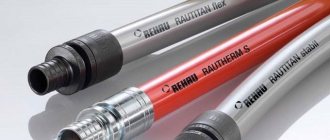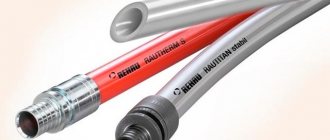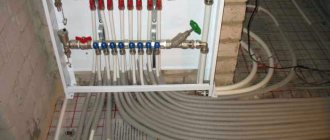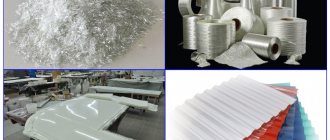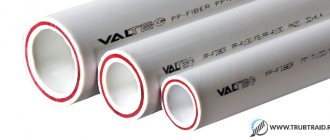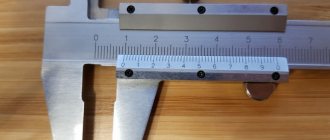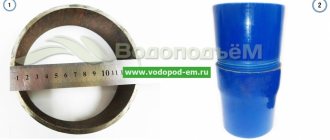For a long time now, polypropylene pipes have been replacing the usual metal ones from everyday life. This is due to their good performance characteristics, which were improved with the help of advanced technologies, including reinforcement. Today, polypropylene pipes are used in many areas of life. With their help, pipelines for heating and hot water systems are repaired and installed. Thanks to their high characteristics, plastic communications last a long time. It is durability, reliability and low cost that make them very popular on the market.
Below we will look at what pressure polypropylene heating pipes can withstand and what operating temperatures they are designed for. This will help you choose the most optimal systems for arranging heating and hot water supply.
Properties of polypropylene
This material is quite resistant to various impacts, as shown by the characteristics below. It is resistant to high temperatures (melts at 175°C), while it has good hardness, high resistance to bending, and low vapor and gas permeability. In addition, it has good wear resistance, which makes it quite durable. Thanks to its unique structure, this material is not afraid of chemicals. Therefore, it is not afraid of solvents (alcohols, ethers, ketones and even acids) contained in water heated to 60 degrees or more. He is also not afraid of the effects of salts and alkalis.
The disadvantage of polypropylene is sensitivity to light, which must be taken into account when using products made from this material in all areas. Under the influence of light and atmosphere, irreversible destructive processes occur in polypropylene, as a result of which it loses its shine, cracks and burns out. To prevent these unfavorable processes, special additives are added to the polypropylene composition.
Another disadvantage of this material is its low frost resistance (brittleness threshold from -5 to -15 °C), but this can also be eliminated by adding ethylene units or ethylene-propylene rubber to the molecular lattice of polypropylene.
Reinforced polypropylene pipes
The main problem with the operation of polypropylene pipelines is their linear (lengthwise) expansion when used in heating and hot water supply. In these cases, the pipe can lengthen up to 10 cm per 1 m. Therefore, it is necessary to install compensators.
This problem is solved with the help of reinforcement (a special reinforcing layer of aluminum or fiberglass is added to the pipe wall). The essence of reinforcement is to increase the physical and mechanical properties of plastic.
This is what allows plastic pipes to compete with their metal counterparts in many respects. Products with fiberglass are marked – PPR-FB-PPR.
Multilayer (reinforced) pipe was developed specifically for high-pressure water supply systems.
Reinforced polypropylene pipe has the following advantages:
- resistant to chemical attack;
- does not emit substances hazardous to human health, therefore suitable for use in everyday life and the food industry;
- smooth inner surface, no sediment or scale deposits; dielectric;
- low noise and thermal conductivity;
- costs less than metal analogues;
- It weighs little, so it is easier to transport and install;
- the expansion coefficient is 5 times lower than that of products made from conventional polypropylene;
- withstands high temperatures and loads.
A pipe that will not burst due to frost.
RSS Article Feed:
Search articles:
When communicating with us, we are often asked the question, which pipes can withstand freezing of water in them?
In this regard, we decided to prepare a separate article on this topic.
So. Everyone knows that when water freezes, it increases in volume, leading to excessive pressure on the walls of the pipe and fittings. Moreover, regardless of the pipe material, there is a rule for all pipelines and fittings - the smaller the diameter of the pipe, the better it will survive the freezing of water in it.
Of all materials, polypropylene is categorically not suitable for systems in which defrosting may occur. This is due to the fact that at temperatures below 5 degrees it becomes very fragile (it is even prohibited to transport it at such temperatures) and when the water expands in such a pipe, it will definitely burst.
Moreover, the “metal plastic” will withstand one, two, or maximum three times of freezing. Even if it is marked that it is made of “cross-linked polyethylene”. As soon as the layer of reinforcing aluminum breaks, a hernia will soon appear in this place, and with subsequent freezing, a breakthrough will occur in this place due to the too thin thickness of the pipe (in a metal-plastic pipe, aluminum plays a load-bearing function and if it ruptures, the pipe is no longer in able to withstand specified loads)
Steel and stainless steel will most likely survive freezing, especially with small diameters, but only a limited number of times. This is due to the fact that each time the water freezes in the pipe, it will expand in its diameter and will eventually burst.
Copper easily withstands freezing. Copper is a very plastic material; when water freezes in it, it neutralizes expansion due to the elasticity of the wall. If there is not enough elasticity, then the pipe wall will simply stretch. Copper itself tolerates this very easily, and it does not become brittle at subzero temperatures (like any polymer). The only problem is that in copper pipelines, when water freezes in them, water can appear at the joints, since when the pipe expands, the solder layer can be damaged. Therefore, the best connection for pipelines that may be susceptible to freezing is copper under the “press connection”.
HDPE pipes also withstand the freezing test very well. But “fittings” and connections often fail.
A cross-linked polyethylene pipe like “REHAU” or “TECE” can withstand a very large number of defrosting cycles, the fact is that these pipes consist entirely of cross-linked polyethylene, which has shape memory. That is, after the pipe expands when it freezes, it will again restore its shape when it thaws. This statement is indirectly confirmed, including by the instructions for installing these pipes. The fact is that pipes made of cross-linked polyethylene, during installation, are first expanded with a special nozzle, then put on a fitting, and then fixed with a “slide-on” sleeve. That is, expansion for this pipe does not threaten anything, unlike other plastics. This pipe is also much less fragile when frozen. As for the “fittings” for these pipes, I couldn’t break them either, perhaps it’s due to their very large margin of safety and the materials used.
Below are prototypes of "REHAU" pipes, (gray color), "TECE" (white and pearl color) and "LAVITA" (corrugated stainless steel pipe). After 25 cycles of freezing to -25 degrees and subsequent defrosting in hot water, with a system pressure of 40! atmospheres For comparison, the pressure in the water supply should not exceed 6 atmospheres!
I would like to pay special attention to the “fittings”. At the beginning of the test, I had no doubt that all these pipes would withstand freezing, but I seriously doubted that the fittings would withstand it. I turned out to be wrong and the brass and plastic “fittings” for cross-linked polyethylene pipes passed the test perfectly, and even on the “LAVITA” pipe no leaks were detected. The taps fell apart instantly, the fake Buggatis also burst in place of the ball element, but the taps, oddly enough, withstood all the tests very well, while maintaining their functionality. The LAVITA pipe itself passed the tests, there were no ruptures, but it lost its shape, greatly elongating in length and increasing in diameter.
Just for fun, we tried to freeze this pipe without pumping excess pressure into it, but as a result, the expansion was not so obvious.
After 5 cycles of freezing the pipe to -25 degrees and then defrosting the pipe using an open flame, the pipe was tested at a pressure of 20 atm, which passed with flying colors.
Next, I would like to present to your attention a test of a copper pipe.
This is such a beauty, by the way, this time we decided to try a much larger pipe diameter. D28.
They installed a plug on it, which was purchased at the nearest market, filled it with water, and without excess pressure in it, they put it in the same freezer with a temperature of -25.
In the end we got the following.
The pipe remained intact, but the plug was simply squeezed out. Which was quite expected for us, because the insufficient thickness of this Chinese fitting is visible to the naked eye.
The pipe itself has not suffered any damage to this day; together with the sample shown at the beginning of the article, it is in our office and is shown to everyone.
If, however, your pipelines in your house have frozen, I highly recommend that you read the information at this link.
What pressure can polypropylene pipes withstand?
In the process of choosing the optimal material for plumbing and heating, the buyer has a question: what pressure is the polypropylene pipe designed for? To do this, you need to study their markings:
- PN 10 – designed for a nominal pressure of 1 MPa and a water temperature of 45°C (single-layer for cold water supply).
- PN 16 – designed for a nominal pressure of 1.6 MPa and a water temperature of 50°C (single-layer for cold water).
- PN 20 – designed for a nominal pressure of 2.0 MPa and a liquid temperature of 80°C (can be single-layer or multi-layer (reinforced), intended for heating and transporting hot water).
- PN 25 – designed for a nominal pressure of 2.5 MPa and a water temperature of 95°C (can be single-layer or multi-layer (reinforced), designed for heating systems and water supply for hot water).
If you are used to calculating pressure in atmospheres and you need to understand how many atmospheres a particular pipe can withstand, then 1 MPa = 9.87 atm.
In any case, despite the maximum permissible loads, it is not advisable to use even reinforced plastic pipes for a long time in the maximum permissible modes (maximum coolant temperature and maximum permissible pressure).
Polypropylene pipes, when heated strongly, lose their unique qualities and are destroyed under the influence of high pressure. Pipeline joints are also very susceptible to overheating and high pressure. If you want to maximize their service life, you need to constantly monitor their tightness.
In heating systems, water often circulates at a pressure of 1.6 MPa and higher, and hot water is mainly supplied to the hot water supply at a pressure of 0.2 - 2.0 MPa. When pipelines are operated at maximum permissible temperatures and pressures, their service life is significantly reduced. That is why you need to follow the manufacturers' recommendations.
A little history
At the end of the Soviet era, despite the global shortage, microdistricts of houses were built in the regions of the Far East according to a standard design, popularly called Leningradsky.
During the construction of these houses, an attempt was made to reduce the cost of construction. The walls of the houses were made of panels, but the windows were triple glazed. The heating devices are convectors of a strange design, a curved pipe with an internal diameter of no more than 20 mm with thin steel plates tightly strung on it.
The Far Eastern climate is harsh, with winter temperatures dropping below -30⁰C. When there is a strong wind, the heat loss of a panel house becomes simply enormous and tiny convectors, designed for completely different operating conditions, simply cannot cope with the task. In order to somehow compensate for heat loss, it was necessary to increase the temperature of the coolant beyond 100⁰С, fortunately the parameters of the heating mains allowed this.
Unfortunately, many residential buildings do not have an automated water supply control system. And the prospects for its appearance are vague. When the outside temperature drops to 35⁰C, the thermal power plant, to maintain the temperature regime, raises the coolant readings to 130⁰C. Thanks to pressure, water continues to flow through the pipes, not steam (about
What temperature can polypropylene pipes withstand?
Polypropylene is a polymer, so it cannot withstand high heat. When heated to 140°C, it softens and can become deformed. When heated to 175°C, the material completely melts.
What temperature can a polypropylene pipe withstand? The maximum water temperature that can be transported is 95°C. Of course, it can withstand higher temperatures, but only for a short time. In other words, if you use a polypropylene pipe for a long time to transport coolant heated to 100°C or more, its service life is reduced significantly.
Heating systems mainly circulate water at a temperature of 90°C. DHW systems supply hot water heated to 65°C. Polypropylene, like many materials, changes in size with temperature changes. In other words, when heated it expands, and when cooled, on the contrary, it contracts. At maximum water temperatures, the plastic bends, sags and swells.
Geometric dimensions
I've used a lot of polypropylene pipes, and none have ruptured or cracked yet. Once I was buying a fairly large batch at the market and at home in a pile of pipes I saw one pipe that was clearly “from the wrong batch.” I asked to give me the Calde . I received pipes of the required brand, but one pipe TERMIK Germany . And I was too lazy to take it back to change it. And I made a mistake. The pipe turned out to be smaller in diameter. When I inserted it into the soldering iron, it practically dangled. When I took it out, it turned out that a third of the pipe had not even melted. However, I inserted it into the fitting. I really hoped that the well-heated fitting would “grab” the pipe. I hoped that it just didn’t seem to melt, but that as soon as it came into contact with the melted fitting, everything would be fine. But the experiment ended in failure. The fittings were at both ends of this unfortunate pipe and both leaked. I was strangled by a toad and I decided to try to fix these connections. And he fixed it. And I won’t go to that tent again. This is how, dear businessmen, good clients move to other companies. In particular, to supermarkets, where not everything is cheaper than on the market, but there is no such annoying mismatch. And heaps of other excesses, by the way.
So let's look at the sizes
A laboratory is not needed for experiments. All you need is a caliper, and I have it! Moreover, German. Moreover, it was made more than 30 years ago. For experiments, we will take the rest of a Turkish pipe (unfortunately I don’t know which one), the ill-fated TERMIK and a pipe from the Russian manufacturer Politek (bought in a supermarket). All samples are 40 mm. Note! I measure with an accuracy of 0.05 mm
| 7.20 | ||
| Türkiye | 40.50 | 7.65 |
| Termik | 40.15 | 7.10 |
Draw your own conclusions. As I already said, Termik dangles in the soldering iron and as a result the connection is not soldered. Thirty-five hundredths of a millimeter, as you can see, is crucial!


